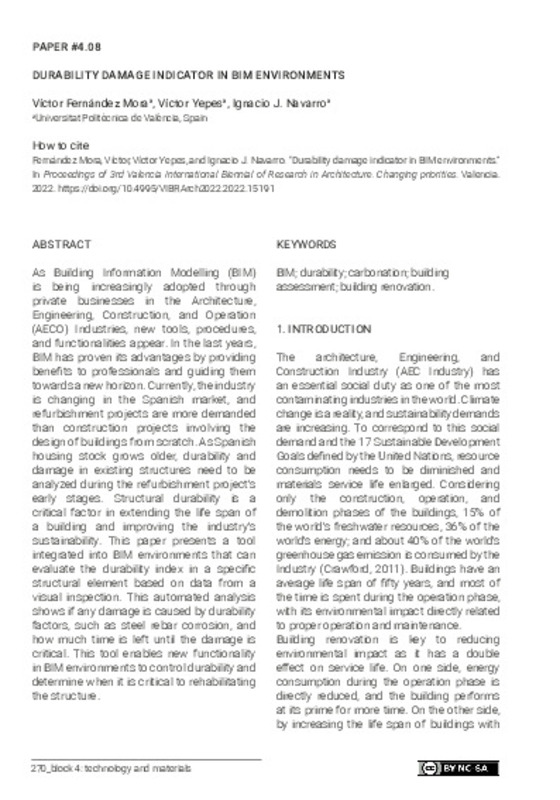JavaScript is disabled for your browser. Some features of this site may not work without it.
Buscar en RiuNet
Listar
Mi cuenta
Estadísticas
Ayuda RiuNet
Admin. UPV
Durability damage indicator in BIM environments
Mostrar el registro sencillo del ítem
Ficheros en el ítem
| dc.contributor.author | Fernández Mora, Victor
|
es_ES |
| dc.contributor.author | Yepes Piqueras, Víctor
|
es_ES |
| dc.contributor.author | Navarro Martínez, Ignacio Javier
|
es_ES |
| dc.date.accessioned | 2023-12-21T08:35:13Z | |
| dc.date.available | 2023-12-21T08:35:13Z | |
| dc.date.issued | 2023-05-22 | |
| dc.identifier.isbn | 9788413960265 | |
| dc.identifier.uri | http://hdl.handle.net/10251/200997 | |
| dc.description.abstract | [EN] As Building Information Modelling (BIM) is being increasingly adopted through private businesses in the Architecture, Engineering, Construction, and Operation (AECO) Industries, new tools, procedures, and functionalities appear. In the last years, BIM has proven its advantages by providing benefits to professionals and guiding them towards a new horizon. Currently, the industry is changing in the Spanish market, and refurbishment projects are more demanded than construction projects involving the design of buildings from scratch. As Spanish housing stock grows older, durability and damage in existing structures need to be analyzed during the refurbishment project's early stages. Structural durability is a critical factor in extending the life span of a building and improving the industry's sustainability. This paper presents a tool integrated into BIM environments that can evaluate the durability index in a specific structural element based on data from a visual inspection. This automated analysis shows if any damage is caused by durability factors, such as steel rebar corrosion, and how much time is left until the damage is critical. This tool enables new functionality in BIM environments to control durability and determine when it is critical to rehabilitating the structure. | es_ES |
| dc.format.extent | 11 | es_ES |
| dc.language | Inglés | es_ES |
| dc.publisher | Editorial Universitat Politècnica de València | es_ES |
| dc.relation.ispartof | Proceedings - 3rd Valencia International Biennial of Research in Architecture, VIBRArch | |
| dc.rights | Reconocimiento - No comercial - Compartir igual (by-nc-sa) | es_ES |
| dc.subject | BIM | es_ES |
| dc.subject | Durability | es_ES |
| dc.subject | Carbonation | es_ES |
| dc.subject | Building assessment | es_ES |
| dc.subject | Building renovation | es_ES |
| dc.title | Durability damage indicator in BIM environments | es_ES |
| dc.type | Capítulo de libro | es_ES |
| dc.type | Comunicación en congreso | es_ES |
| dc.identifier.doi | 10.4995/VIBRArch2022.2022.15191 | |
| dc.rights.accessRights | Abierto | es_ES |
| dc.contributor.affiliation | Universitat Politècnica de València. Escuela Técnica Superior de Ingenieros de Caminos, Canales y Puertos - Escola Tècnica Superior d'Enginyers de Camins, Canals i Ports | es_ES |
| dc.contributor.affiliation | Universitat Politècnica de València. Departamento de Ingeniería de la Construcción y de Proyectos de Ingeniería Civil - Departament d'Enginyeria de la Construcció i de Projectes d'Enginyeria Civil | es_ES |
| dc.contributor.affiliation | Universitat Politècnica de València. Instituto de Ciencia y Tecnología del Hormigón - Institut de Ciència i Tecnologia del Formigó | es_ES |
| dc.description.bibliographicCitation | Fernández Mora, V.; Yepes Piqueras, V.; Navarro Martínez, IJ. (2023). Durability damage indicator in BIM environments. Editorial Universitat Politècnica de València. 270-280. https://doi.org/10.4995/VIBRArch2022.2022.15191 | es_ES |
| dc.description.accrualMethod | OCS | es_ES |
| dc.relation.conferencename | 3rd Valencia International Biennial of Research in Architecture, VIBRArch | es_ES |
| dc.relation.conferencedate | Noviembre 09-11, 2022 | es_ES |
| dc.relation.conferenceplace | Valencia, España | es_ES |
| dc.relation.publisherversion | http://ocs.editorial.upv.es/index.php/VIBRArch/VIBRArch2022/paper/view/15191 | es_ES |
| dc.description.upvformatpinicio | 270 | es_ES |
| dc.description.upvformatpfin | 280 | es_ES |
| dc.type.version | info:eu-repo/semantics/publishedVersion | es_ES |
| dc.relation.pasarela | OCS\15191 | es_ES |








